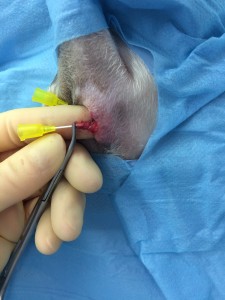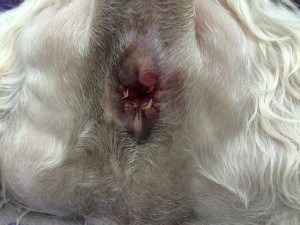Betty’s facelift
Meet Betty the lovely Bassett Hound. Betty is 3 years of age and as you can see from the photog..
+ Read moreYes is the answer, but here are some things to understand and consider in the surgical decision making process for each patient. Firstly, what are anal sacs? They are two secretory sacs located within the circular anal muscles called the internal and external anal sphincter. The sacs accumulate a smelly fluid which is expelled when a patient passes feaces, as a type of scent marking. For most patients this is an uneventful natural act, but for others, they may experience blocked sacs where the secretions get trapped and cannot escape via the duct. The secretions trapped in the sac eventually burst the through the sac , setting up an abscess with the surrounding muscles, a very painful situation for any pet. Dogs are more frequently affected than cats with the condition of anal sacculitis due to the fact that cats have a more fatty consistency to their anal sac secretions, making the duct less likely to obstruct. The first time an anal sac abscess occurs, it can often be resolved by clipping away the matted fur, warm water compresses and the use of anti-inflammatory / pain killers and a short course of antibiotics.
When should anal sacs be removed then? If a patient has recurrent infections in the anal sacs, blocked sacs, persistent anal irritation seen as scooting the bottom along the floor or biting at the back end, constant leaking of smelly anal sac fluid necessitating frequent anal sac expression every month, then removal can be considered.
What does surgery entail? The two aims of surgery are :
The technique used by visiting vet specialist Catherine, is a partial open and closed technique, with catheterisation of the duct and sac to clearly demarcate the position of each anal sac for careful dissection. Usually, only skin sutures are placed ensuring the cavity where each anal sac has been located heals quickly and does not have to further dissolve deeper suture material, which in itself will incite inflammation in this delicate region.
Could there be complications? In the hands of a surgical specialist, at most you may expect for a period of 3-7 days a temporary reduction in anal tone due to muscle fibre disruption. This normally manifests itself as with occasional dropping of feaces or feacal smearing when sitting down. Some patients however, do not experience any temporary reduction in anal tone despite both anal sacs being removed, but we would normally advise keeping the patient in an area of the home that is easy to clean until you can establish if they are going to need a slightly more intense few days of bottom cleaning until the anal tone returns.

